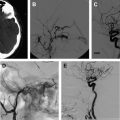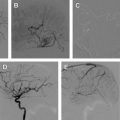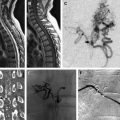Childhood intracranial aneurysms differ from those in the adult population in incidence and gender prevalence, cause, location, and clinical presentation. Endovascular treatment of pediatric aneurysms is the suggested approach because it offers both reconstructive and deconstructive techniques and a better clinical outcome compared with surgery; however, the long-term durability of endovascular treatment is still questionable, therefore long-term clinical and imaging follow-up is necessary. The clinical presentation, diagnosis, and treatment of intracranial aneurysms in children are discussed, and data from endovascular treatments are presented.
Key points
- •
Childhood intracranial aneurysms are rare.
- •
They are distinct pathologically from adult aneurysms.
- •
They are associated with other congenital diseases.
- •
They have a higher incidence of de novo growth and recurrence.
- •
The endovascular method is the main treatment modality.
Introduction
Intracranial aneurysms in children are rare. ( Table 1 ) shows the larger series of intracranial pediatric aneurysms to date. Most of the risk factors associated with intracranial aneurysms in adults do not exist in children, therefore the pathogenesis is thought to be different. The location and size of intracranial aneurysms in children differ from those found in adults. Most children with intracranial aneurysms present with subarachnoid hemorrhage (SAH) typically with a good clinical grade. This article reviews the incidence and gender prevalence, cause, location, and different types of intracranial aneurysms in children. The clinical presentation, diagnosis, and treatment of intracranial aneurysms in children are discussed, and data from endovascular treatments are presented.
| Lasjaunias et al, 2005 | Hetts et al, 2009 | Koroknay-Pal et al, 2012 | Mehrotra et al, 2012 | |
|---|---|---|---|---|
| Patients (n) | 59 | 77 | 114 | 57 |
| Number of aneurysms | 75 | 103 | 130 | 73 |
| Age (range) | 7.6 y (8 d–15 y) | 12 y (3 mo–18 y) | 14.5 y (3 mo–18 y) | 12.7 y (4 y–18 y) |
| Sex | M/F 3:2 | F/M 1.1:1 | M/F 3:2 | M/F 1:1.2 |
| Morphology | ||||
| Fusiform (%) | 56 | 31 | 10 | 2.7 |
| Saccular (%) | 27 | 46 | 78 | 78 |
| Infectious (%) | 14 | 12 | 0 | 2.7 |
| Traumatic (%) | 3 | 14 | 7.6 | 8 |
| Giant (>25 mm) (%) | 1.3 | 11 | 12 | 19 |
| Multiple (%) | 15 | 16 | 11 | 11 |
| Anterior Circulation (%) | 73 | 78 | 89 | 71.3 |
| Posterior Circulation (%) | 27 | 22 | 11 | 28.7 |
| SAH (%) | 54 | 32 | 78.1 | 88.7 |
| Mass Effect (%) | — | — | 6.1 | 7 |
| Mortality (%) | 10.4 | 1.3 | 7.7 | 8.7 |
Introduction
Intracranial aneurysms in children are rare. ( Table 1 ) shows the larger series of intracranial pediatric aneurysms to date. Most of the risk factors associated with intracranial aneurysms in adults do not exist in children, therefore the pathogenesis is thought to be different. The location and size of intracranial aneurysms in children differ from those found in adults. Most children with intracranial aneurysms present with subarachnoid hemorrhage (SAH) typically with a good clinical grade. This article reviews the incidence and gender prevalence, cause, location, and different types of intracranial aneurysms in children. The clinical presentation, diagnosis, and treatment of intracranial aneurysms in children are discussed, and data from endovascular treatments are presented.
| Lasjaunias et al, 2005 | Hetts et al, 2009 | Koroknay-Pal et al, 2012 | Mehrotra et al, 2012 | |
|---|---|---|---|---|
| Patients (n) | 59 | 77 | 114 | 57 |
| Number of aneurysms | 75 | 103 | 130 | 73 |
| Age (range) | 7.6 y (8 d–15 y) | 12 y (3 mo–18 y) | 14.5 y (3 mo–18 y) | 12.7 y (4 y–18 y) |
| Sex | M/F 3:2 | F/M 1.1:1 | M/F 3:2 | M/F 1:1.2 |
| Morphology | ||||
| Fusiform (%) | 56 | 31 | 10 | 2.7 |
| Saccular (%) | 27 | 46 | 78 | 78 |
| Infectious (%) | 14 | 12 | 0 | 2.7 |
| Traumatic (%) | 3 | 14 | 7.6 | 8 |
| Giant (>25 mm) (%) | 1.3 | 11 | 12 | 19 |
| Multiple (%) | 15 | 16 | 11 | 11 |
| Anterior Circulation (%) | 73 | 78 | 89 | 71.3 |
| Posterior Circulation (%) | 27 | 22 | 11 | 28.7 |
| SAH (%) | 54 | 32 | 78.1 | 88.7 |
| Mass Effect (%) | — | — | 6.1 | 7 |
| Mortality (%) | 10.4 | 1.3 | 7.7 | 8.7 |
Incidence and gender prevalence
Intracranial aneurysms in children are rare; 0.5% to 4.6% of intracranial aneurysms occur in patients aged 18 years or younger. In a cooperative study reported in 1966, only 41 of 6368 (0.6%) ruptured aneurysms were found in patients younger than 19 years. In children, boys are more likely to harbor aneurysms than are girls. After puberty, women have a 3 to 5 times higher incidence of aneurysms than men. In some reports, a female dominance has been found before the age of 2 years. Other reports that include older children have shown a less evident male dominance.
Causes
Cerebral aneurysms are often thought to form as a result of chronic hemodynamic stress at branch points of arteries or areas where arteries abruptly change curvature. The classic risk factors in adults are largely acquired, such as hypertension, obesity, high cholesterol, diabetes, alcohol abuse, and smoking, and are often absent in children. Many pediatric patients have medical comorbidities that may be related to an underlying genetic abnormality or developmental defect in the arterial tissue. Such factors might predispose these patients to aneurysm formation at a faster rate than that in patient without these factors, accounting for their earlier clinical presentation. Pediatric aneurysms are associated with conditions such as polycystic kidney disease, fibromuscular dysplasia, Ehlers-Danlos syndrome, Klippel-Trénaunay syndrome, tuberous sclerosis, moyamoya syndrome, hereditary hemorrhagic telangiectasia, pseudoxanthoma elasticum, or Marfan disease. There is also a higher incidence of traumatic aneurysm.
Aneurysms are called saccular or berry when they have a saccular appearance, and dissecting when the aneurysm has a fusiform appearance and has preaneurysmal or postaneurysmal narrowing. Childhood cerebral aneurysms are morphologically different from their saccular counterparts in adults, including a high number of fusiform shape, giant size, and de novo formation. Dissecting aneurysms are dominant during the first 5 years of life, whereas saccular aneurysms are more common in children older than 6 years.
Aneurysm features
The size and location of aneurysms in children are different than those found in the adult population. Aneurysms of the internal carotid artery (ICA) occur with similar frequency in both populations; however, there is a greater incidence of ICA terminus aneurysms in the pediatric population. Aneurysms of the anterior cerebral artery (ACA) including the anterior communicating artery occur 34% of the time in the adult population, whereas, in children, recent reviews have encountered ACA aneurysms only about 5% to 10% of the time. Aneurysms involving the middle cerebral artery occur in a similar distribution in both adults and children. Posterior circulation aneurysms are more common in children, occurring approximately 25% of the time. In contrast, in the adult population they occur in only 8% of patients presenting with an aneurysm. The multiplicity of saccular aneurysms in children is low compared with adults, except in children with aneurysms of infectious origin. In our series, 33% of aneurysms were located in the ICA, 33% in the middle cerebral artery, 17% in the posterior cerebral artery, 8% in the posterior communicating artery, and 8% in the basilar artery.
Traumatic Aneurysms
Traumatic aneurysms account for about 5% to 40% of pediatric aneurysms. These aneurysms usually involve the distal ACA adjacent to the falx (40%), involve the major vessels along the skull base (35%), or have a cortical location (25%). The child usually presents with a hemorrhagic episode about 4 weeks after the initial injury; however, immediate bleeding has also been reported. Most children have sustained a closed head injury, but other causes include penetrating injuries and surgery.
Infectious Aneurysms
Infectious aneurysms account for 5% to 15% of pediatric aneurysms. They are most often of bacterial origin. The most common organism is staphylococcus, followed by streptococcus and other gram-negative organisms. Infectious arterial aneurysms are usually caused by bacterial endocarditis in infants with congenital or rheumatic heart disease. Infections involving the sphenoid sinus or mastoid air cells and sinus thrombophlebitis may also involve the adjacent artery causing an infectious aneurysm. Infectious arterial aneurysms have also been observed in children with chronic mucocutaneous candidiasis and human immunodeficiency virusinfection.
Saccular Aneurysms
Saccular aneurysms are the most common type of aneurysm occurring in the pediatric population (between 46% and 70%). The cause of saccular aneurysms is unknown. They usually occur at bifurcation points of vessels, suggesting hemodynamic factors.
Dissecting Aneurysms (Nontraumatic)
Dissecting aneurysms in the pediatric population occur 4 times more often than in the adult population. This type of aneurysm can occur in the anterior or posterior circulation, especially the P1 and P2 segments of the posterior cerebral artery, supraclinoid ICA, and middle cerebral artery. Hetts and colleagues, in the largest reported series, evaluated 77 patients with 103 intracranial aneurysms and showed a greater incidence of dissecting aneurysms in the anterior circulation. Lasjaunias and colleagues, in their series of 59 consecutive children with 79 aneurysms, showed an almost equal distribution between the anterior and posterior circulation. Agid and colleagues, in their series of 33 patients with 37 aneurysms, showed that most dissecting aneurysms involve the posterior circulation. There are reports of dissecting aneurysms in children healing spontaneously with occlusion of the parent artery.
Giant Aneurysms
Giant aneurysms (>25 mm) in children are about 4 times more common than in adults. Their reported incidence in children is between 25% and 45%. Giant aneurysms should be considered in the dissection category. Children who have giant aneurysms often present with mass effect and only 35% of the time with SAH.
Stay updated, free articles. Join our Telegram channel

Full access? Get Clinical Tree






